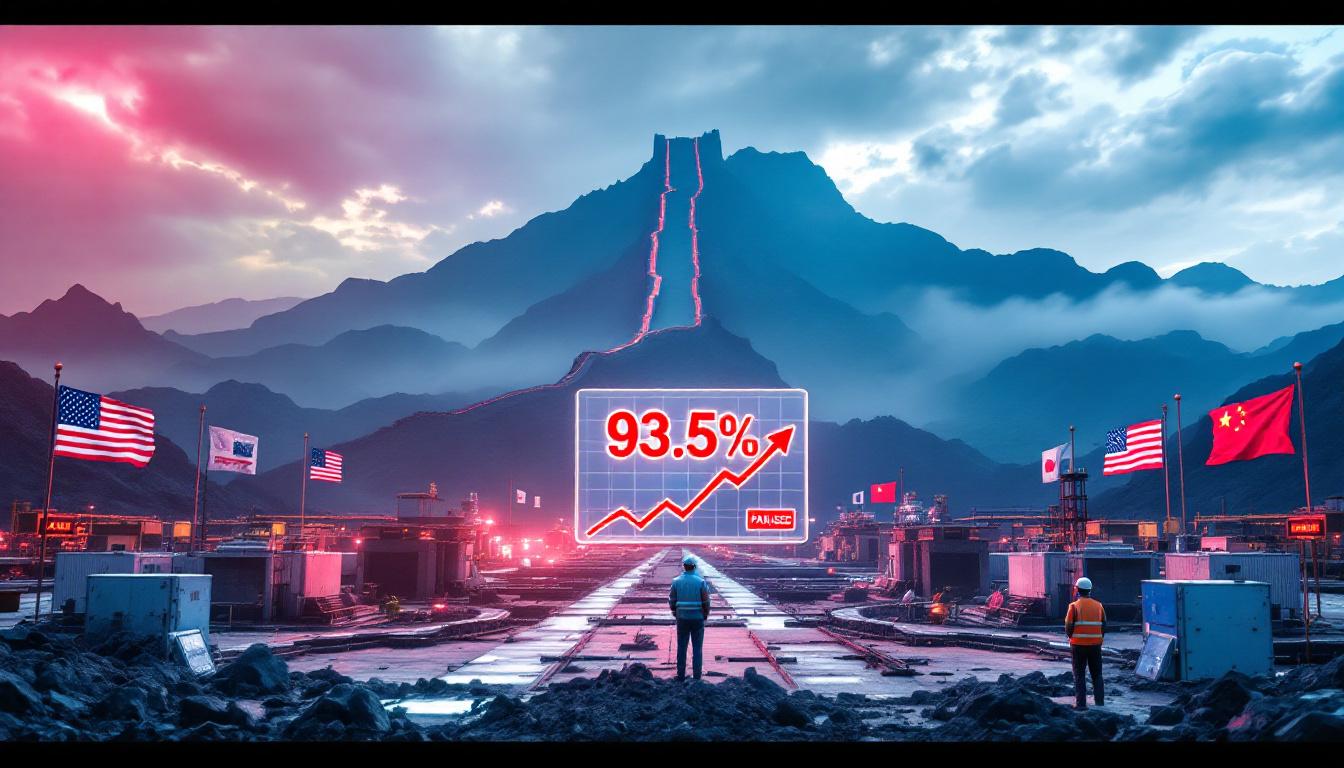What is the Current State of the Global Economy?
The global economy is showing clear signs of a slowdown as we move through 2025, with multiple indicators suggesting we may already be in the early stages of recession. First-quarter GDP reports have turned negative according to prominent market analyst Jesse Felder, and various soft data metrics reinforce concerns about economic contraction. Business capital expenditure plans are increasingly being shelved across various sectors as corporations adopt a cautious stance amid uncertainty.
This economic hesitation extends beyond corporate boardrooms to consumer behavior, where spending patterns show a marked shift toward conservatism. Major food service chains including McDonald's and Chipotle have reported weakness in consumer spending during recent earnings calls, revealing early signs of belt-tightening among households.
Signs of Economic Slowdown
The evidence for economic deceleration has become difficult to ignore. Port activity metrics reveal alarming trends, with major shipping hubs reporting significant declines in container traffic. According to supply chain expert Chris Muan, some ports are processing approximately 54 fewer container shipments weekly compared to previous periods, creating ripple effects throughout the supply chain.
"We're close to, if not already in recession… consumers are acting in a much more conservative way," notes Jesse Felder in his economic assessment. This consumer pullback resembles pre-recessionary behavior observed in previous economic cycles, with households becoming increasingly selective and value-conscious in their purchasing decisions.
Consumer Behavior Changes
Consumer-focused companies are documenting significant shifts in spending habits that typically precede broader economic contractions. Beyond large fast-food chains, retailers across various price points report customers trading down to lower-cost alternatives and reducing discretionary spending.
These behavioral changes create a self-reinforcing cycle: as consumers spend less, businesses see declining revenues, leading to reduced hiring or even layoffs, which further constrains consumer spending power. Current inventory levels in some regions stand at approximately seven weeks of typical products, with replenishment channels facing significant constraints as importers hesitate to place new orders.
Inflation Concerns Amid Slowing Growth
Despite clear economic deceleration, inflation metrics remain stubbornly elevated. Median CPI has only fallen to approximately 3.5% from previous peaks and shows troubling signs of potential increases in the months ahead. This combination creates the worst possible economic scenario: stagflation.
"The mix of slowing growth alongside persistent inflation creates a particularly challenging environment for policymakers," explains Felder. Central banks face an impossible dilemma – raise rates to fight inflation while potentially deepening a recession, or cut rates to stimulate growth at the risk of reigniting inflation. This policy conundrum makes navigating the current economic landscape exceptionally difficult for investors and businesses alike.
How Are Trade Policies Affecting Global Markets?
Recent trade policy shifts under the current administration are creating significant market volatility and supply chain disruptions. The implementation of new tariffs has triggered a cascade of effects throughout global commerce, with businesses struggling to adapt to rapidly changing conditions.
Tariff Policy Impacts
The cycle of tariff implementation, followed by negotiation pauses and potential renegotiation, has created an environment where long-term planning becomes nearly impossible for businesses dependent on international trade. With major economies engaged in ongoing trade tensions, the 90-day pause on certain tariffs impact markets announced in May 2025 has provided only temporary relief to affected industries.
Companies are forced to make rapid decisions about inventory management, pricing strategies, and supply chain restructuring without clarity on future trade policies. This uncertainty manifests as increased costs, which eventually reach consumers through higher prices for everyday goods.
Supply Chain Disruptions
"Tariffs will create almost like a mini-COVID… shelves will start disappearing," warns Chris Muan, highlighting the potential for significant consumer impacts. The disruption at major ports has created bottlenecks throughout the supply chain, with container shipments declining significantly.
These disruptions bear a concerning resemblance to those experienced during the pandemic, but with different underlying causes. While COVID-19 created sudden demand spikes alongside supply constraints, current disruptions stem from policy decisions affecting trade flows. Entrepreneurs with importing experience report rushing orders to beat tariff deadlines, creating inventory gluts in some categories while shortages develop in others.
Price Inflation Risks
The supply-demand imbalances created by trade disruptions establish perfect conditions for another round of inflation despite broader economic weakness. As inventories deplete without adequate replenishment channels, consumers face both higher prices and limited product availability.
This dynamic particularly affects sectors reliant on components or finished goods from countries targeted by new tariff policies. The resulting price pressures come at the worst possible time – just as consumers are already displaying increased price sensitivity and reduced spending capacity due to previous inflation impacts on household budgets.
What's Happening in the Stock Market?
Technical indicators suggest the stock market may be transitioning from a bullish to a bearish environment, with concerning similarities to previous market tops. The weekly chart patterns of major indices display characteristics that veteran analysts find troublingly familiar.
Technical Market Analysis
"The current S&P 500 pattern looks remarkably similar to what we saw in 2008 before the first major crack in the markets," explains Chris Muan. Recent market rallies demonstrate the hallmarks of what traders call "dead cat bounces" – temporary upward movements within a broader downtrend rather than sustainable recoveries.
Market momentum indicators show bearish divergences, where price makes new highs while underlying strength metrics fail to confirm these moves. This technical deterioration often precedes meaningful corrections as it reveals weakening market foundations despite surface-level price resilience.
Insider Trading Signals
Perhaps the most concerning signal comes from corporate insiders whose actions provide unique forward-looking insights into market direction. "Insider selling is perhaps the best leading indicator of stock prices 18-24 months ahead," notes Jesse Felder, pointing to the ratio of insider selling to buying that has reached alarming levels.
The 12-month ratio exceeding 20:1 (dollars sold to bought) represents extreme pessimism among those with the closest view of corporate performance. Historically, such elevated selling-to-buying ratios have preceded earnings recessions and bear markets by approximately 18-24 months. When corporate executives and board members actively reduce their own equity exposure, investors should take note.
Market Sentiment Indicators
Additional concerning signs appear in investor sentiment metrics. Search trend data for terms like "bear market" have spiked recently, similar to patterns observed before previous significant market corrections. Meanwhile, substantial capital continues flowing into leveraged long ETFs, indicating potentially excessive optimism despite deteriorating fundamentals.
This combination of retail enthusiasm alongside insider selling creates a classic setup for market vulnerability. The FOMO (fear of missing out) indicator has reached levels that historically signal impending market pullbacks, as retail investors chase returns at precisely the wrong moment while institutional smart money quietly exits positions.
Is a Recession Already Underway?
The traditional definition of a recession – two consecutive quarters of negative GDP growth – may soon be met based on current economic trajectories. However, official recession declarations from the National Bureau of Economic Research (NBER) typically come with significant delays, creating a disconnect between economic reality and official recognition.
Economic Indicator Analysis
"NBER won't confirm a recession until late 2025," predicts Jesse Felder, highlighting the typical 6-9 month lag between recession onset and official declaration. This delay occurs because the NBER committee evaluates a broad range of indicators beyond just GDP, including employment, industrial production, and personal income.
The Q1 2025 GDP report already showed negative growth, though inventory adjustments may have skewed the numbers somewhat. If Q2 follows with another negative reading, the technical definition of recession will be satisfied regardless of when the NBER committee makes its official determination.
Real Estate Market Concerns
The real estate sector displays particularly troubling signs of weakness after years of appreciation driven by low interest rates. "Real estate… the bottom's about to drop out," warns Chris Muan, highlighting the vulnerability of property valuations in the current economic environment.
This potential real estate correction creates a rare and dangerous scenario where both major asset classes – stocks and real estate – could experience simultaneous declines. "Two biggest asset classes will be dropping," notes Muan, a situation that would place extraordinary pressure on household wealth and consumer confidence.
Stagflation Probability
The combination of slowing growth alongside stubbornly elevated inflation increases the probability of stagflation – an economic condition not seen at scale since the 1970s. This environment creates a particularly difficult challenge for monetary policy, as central banks must choose between fighting inflation (requiring tighter policy) or stimulating growth (requiring looser policy).
The stagflationary dilemma traps policymakers in an impossible position, with any action likely to worsen one side of the equation. This policy limitation means economic participants may need to endure the full business cycle without the relief of effective intervention, potentially extending the duration of economic pain.
What's Driving Gold's Performance?
Gold has entered what appears to be a new super cycle that began around 2019, emerging from a multi-year base formation. The precious metal's recent strength reflects both monetary concerns and geopolitical uncertainties driving safe-haven demand.
Gold Price Cycle Analysis
"Gold will bottom before equities," predicts Chris Muan, explaining the typical relationship between gold and broader markets during economic transitions. Technical analysis suggests long-term targets around $5,100 per ounce, though not without significant volatility along the way.
Recent price action has reached key Fibonacci extension targets around $2,750-$2,800, potentially signaling a near-term exhaustion point. Monthly chart patterns show characteristics of a blow-off top formation, which typically precedes meaningful corrections within longer-term uptrends.
Market Cycle Relationship
Gold demonstrates a specific pattern during economic transitions that investors should understand. As equity markets experience their first significant corrections during cycle turns, gold typically outperforms as investors seek defensive positioning.
However, during subsequent deeper market corrections, gold frequently experiences temporary downward pressure. This occurs during what analysts call the "liquidation phase," when investors sell assets indiscriminately to raise cash or meet margin calls. This pattern was clearly visible during the 2008 financial crisis, when gold initially rallied before experiencing a sharp pullback, only to bottom before equities and begin a stronger multi-year uptrend.
Potential Correction Ahead
Despite the bullish long-term outlook, gold appears vulnerable to a correction in the near term. "A pullback to approximately $2,400 per ounce over the next 6-8 months," suggests Muan, representing a healthy 22-24% consolidation within the broader uptrend.
This correction would provide more sustainable technical foundations for the next leg higher while creating attractive entry points for long-term investors who missed the initial move. Historically, 22-24% corrections after reaching major Fibonacci targets have created important bottoming formations before continuing larger trends.
"Gold will temporarily pull back during the liquidation phase when investors sell everything, but will find its bottom before equities and begin a stronger uptrend." – Chris Muan
The latest gold price forecast indicates significant potential for appreciation over the coming years as geopolitical tensions and economic uncertainties continue to drive safe-haven investment.
How Should Investors Position for Energy Markets?
Energy stocks appear significantly undervalued relative to broader equity markets, creating potential opportunities despite near-term economic challenges. Several metrics highlight the extreme value proposition in the sector, particularly when viewed through historical comparisons.
Energy Sector Valuation
The ratio of gold to oil prices indicates oil has become extremely cheap compared to gold, reaching levels only previously seen during the 2020 market crash when oil prices briefly turned negative. This extreme relative valuation often precedes significant mean reversion.
"The gold/oil ratio is near 2020 lows," notes Jesse Felder, highlighting this historical anomaly. When commodities reach such extreme relative valuations, powerful counter-moves frequently follow as markets eventually recognize and correct imbalances.
Long-Term Structural Factors
Several structural factors support a potentially bullish outlook for energy markets over the longer term. The potential for a secular bear market in the US dollar would likely benefit commodity prices broadly, including energy. Increasing capacity utilization as manufacturing returns to domestic markets would drive additional energy demand, alongside reshoring of production facilities.
Infrastructure investment requirements represent another tailwind, as aging energy infrastructure across developed markets requires substantial capital investment. These structural supports suggest energy may offer compelling value for patient investors who can withstand near-term volatility.
Near-Term Caution Required
Despite favorable long-term fundamentals, energy stocks remain vulnerable to broader market corrections in the near term. "Oil price projection of $45/barrel during economic contraction," cautions Muan, highlighting the risk of significant downside before the value proposition fully materializes.
During significant market downturns, correlation across asset classes typically increases, with most stocks declining regardless of sector. This "correlation convergence" during stress periods means even undervalued sectors can experience significant drawdowns before their relative value becomes apparent through subsequent outperformance.
The potential for an oil price crash similar to 2020 cannot be dismissed, particularly as global economic growth slows and trade tensions escalate through 2025.
What About Other Commodities?
Historical patterns suggest commodities tend to outperform financial assets during periods of declining consumer confidence. Current consumer confidence metrics have recently declined to levels comparable to 2020 lows, creating conditions that have historically favored commodities over stocks.
Commodity Cycle Indicators
Consumer confidence serves as a surprisingly reliable indicator for commodity performance relative to financial assets. As consumer sentiment deteriorates, investment flows typically shift toward harder assets with intrinsic value rather than financial instruments dependent on economic growth.
This relationship has been consistent across multiple economic cycles and appears to be reasserting itself in the current environment. The psychological factors driving this relationship include increased risk aversion and desires for tangible assets during uncertain times.
Uranium Market Potential
The uranium market dynamics show particularly interesting long-term potential among commodity sectors. Uranium prices have established a significant bottoming pattern after a prolonged period of underinvestment in production capacity.
Growing recognition of nuclear power's role in clean energy transitions is driving renewed interest in uranium production. Major utilities like Duke Energy have committed to extending nuclear plant lifespans, securing long-term demand. The sector combines elements of both commodity and technology investment themes as advanced reactor designs create new market applications.
Capital Preservation Strategy
Despite favorable long-term outlooks for various commodities, capital preservation remains the priority in the current environment. Maintaining liquidity to deploy during potential market corrections may prove more valuable than attempting to identify sectors that might outperform during market turbulence.
Cash positions earning approximately 4% through Treasury bills represent a competitive alternative in the current environment. This approach preserves capital while generating reasonable yields compared to historical cash returns, which were often near-zero during previous market cycles.
What Investment Strategies Make Sense Now?
Current market conditions suggest a defensive approach is warranted for investors concerned about preserving capital through a potentially challenging economic transition. Several specific strategies offer protection while maintaining flexibility for future opportunities.
Defensive Positioning
Maintaining significant cash positions in Treasury bills yielding approximately 4% provides both safety and optionality. This approach preserves capital while generating reasonable returns compared to historical cash yields of near-zero during previous market cycles.
Even legendary investor Warren Buffett has maintained an unusually large cash position, indicating caution among the investment community's most experienced participants. This "dry powder" strategy creates the ability to capitalize on investment opportunities that typically emerge during market corrections when quality assets become available at discounted prices.
Bond Market Caution
The bond market presents significant risks despite traditional assumptions about bonds as defensive assets. With inflation potentially establishing a floor around 3.5% and showing signs of potential increases, bonds remain vulnerable to further price declines.
Technical patterns suggest yields could potentially test previous highs in coming months, which would correspond with lower bond prices. This unusual environment has prompted many experienced investors to avoid bonds entirely or maintain only very short-term fixed income exposure through Treasury bills.
Selective Opportunity Identification
While maintaining a defensive overall posture, selective opportunities exist for consideration. Energy stocks showing strong insider buying activity may warrant attention, as corporate insiders often identify value ahead of broader market recognition.
Precious metals deserve consideration for core positions, though with reduced exposure to mining stocks in the near term given their sensitivity to broader market corrections. Building watchlists of quality companies in growth sectors like robotics prepares investors for future deployment when valuations become more attractive.
How Should Investors Prepare for Market Volatility?
Market volatility appears likely to increase based on technical indicators, economic conditions, and historical patterns. Preparing for this volatility requires both strategic positioning and psychological readiness.
Liquidity Preservation
"Having dry powder available allows investors to capitalize on opportunities that emerge during market corrections," emphasizes Jesse Felder, highlighting the strategic advantage of maintaining substantial liquidity during periods of market uncertainty.
This approach requires patience and discipline to resist deploying capital prematurely. The psychological challenge of watching markets from the sidelines can be difficult, but historically has rewarded patient investors who preserve capital during late-cycle environments.
Technical Analysis Guidance
Technical analysis can help identify potential market turning points and guide investment decisions. Current technical patterns suggest markets may be forming important tops, with similarities to previous cycle peaks that preceded significant corrections.
Monitoring key technical levels, momentum indicators, and market breadth metrics provides important signals about potential market direction. While no technical system offers perfect predictive capability, these tools can help investors manage risk by identifying periods of heightened vulnerability.
Focus on Capital Preservation
Prioritizing capital preservation over growth is appropriate in the current environment. The potential downside risks in multiple asset classes suggest defensive positioning will likely outperform aggressive strategies in the near term.
This approach positions investors to emerge from market corrections with capital intact and ready for
Ready to Stay Ahead of Major Mineral Discoveries?
Gain immediate, real-time alerts on significant ASX mineral discoveries through Discovery Alert's proprietary Discovery IQ model, turning complex data into actionable investment insights that could lead to substantial returns. Explore why major mineral discoveries create exceptional market opportunities by visiting the Discovery Alert discoveries page and begin your 30-day free trial today.




